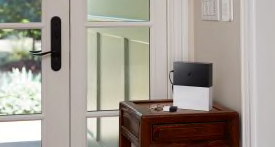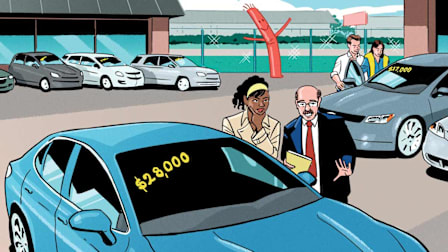How to Negotiate a New-Car Price Effectively
Do your homework before you go to a dealership

Negotiating for a new car might feel comical—like pitting an amateur against a team of professionals. But by setting the ground rules early, you can level the playing field.
There’s more to choosing a car than just finding the lowest possible price. You can’t expect a salesperson to send you to a rival across the street, but good ones know a heck of a lot about the cars they’re selling and whom they might suit. And they’ll try very hard to find the right one for you. If you’re still in shopping mode rather than buy-it-now mode, it would be a mistake to dismiss what they have to say out of hand.
In any case, whether you do your price negotiation by email, using an intermediary buying service, or going one-on-one with a salesperson and, inevitably, their boss, you’re going to wind up at a dealership to sign the papers and get the keys.
When you start bargaining, work from your positions of strength:
• Your opening bid, based on what the dealer paid for the vehicle or what you’ve established is a fair price.
• Competing bids from other local dealerships or car-buying websites.
Set the Ground Rules
Rather than be drawn into a discussion on the salesperson’s terms, let them know:
• You have carefully researched the vehicle you want and have already taken a test drive.
• You know exactly which trim level and options you want, have researched the price for that configuration, and know approximately what the dealership paid for it.
• You have already calculated what you’re prepared to pay. Reassure the salesperson that your offer includes a fair profit.
• If the salesperson can meet your target price, you’ll be ready to buy immediately. If not, you intend to go to other dealerships.
Get Down to Brass Tacks
Start the negotiations with your precalculated low offer. You should base it on the average transaction price for the model and trim level(s) you’re considering. CR focuses on the actual transaction prices rather than the invoice because we think it’s far more useful. It sets a target for what others are paying for the vehicle in your area. The invoice price has become far less meaningful and doesn’t reflect the impact of supply and demand—a big consideration in the current market. Aim for the low end of the transaction price spectrum, available on CR’s car model pages, knowing that you have a fair deal if you match the average transaction price.
After you declare your starting offer, there is usually a back-and-forth process while the salesperson submits your bids to the sales manager and returns with counteroffers. Be prepared for the offers to be far higher than your target price, and be prepared to wait several minutes at each step.
One gambit you can use is to mention that you have competitive bids in hand from other dealers without disclosing what they are. Explain that you’re looking for the lowest markup over your bottom price.
As an alternative, ask whether the salesperson is willing to beat a price you got from a legitimate buying service. If so, tell the salesperson what it is, or better yet, show them a printout.
Try not to be argumentative. Keep working from your lower figure, raising it a little at a time rather than taking the dealer’s counteroffer and hammering it down. If you use the average transaction price as a starting point, you’ll probably have a quick negotiation process. If you start with a lower number, you’ll likely spend more time coming to an agreement.
From the outset, you want to stay on course and prevent the negotiation from veering off-track. If the salesperson asks about a trade-in, for instance, insist on locking down the new car price first.
As for financing, explain that you’re preapproved for a loan and prepared to pay in cash. However, make it known that you may be willing to consider financing through the dealership, provided the offer is competitive. But make it known that coming to terms on the purchase price is the primary focus.
Reassure the salesperson that if you can both agree to terms you find to be fair, they can look forward to making a quick sale. If not, you’ll move on.
You may be shunted to a more senior sales associate or manager. If that happens, simply repeat the same ground rules to that person. But no matter who ends up sitting across the desk from you, a clear explanation of what you’re looking for will help counteract the common diversionary tactics you may come across.
Stay Firm and Hold Your Ground
A salesperson’s initial reaction might be dismissive. They may state flatly that there’s no way the sales manager will let the vehicle be sold at your price. They may even try to tell you that your numbers are wrong. If so, show a printout of your sources of information.
Even if the salesperson can’t find fault with your numbers, they may counter your bid with a barrage of objections, pleas, and ploys to get you to raise your offer. Because the manager wields the real power to approve deals, you can expect this. But make it clear that you don’t have a lot of time to sit around and wait. You also have some wiggle room. After all, the target price that you calculated allowed for a reasonable dealer profit.
While you can allow your target price to go up in small increments, don’t go above the lowest competing bid you’ve gathered. You don’t want to give the impression that you’re simply responding to pressure. It might help to state a rationale for your flexibility on price. For example, you could say that you value the fact the dealership is conveniently close or that you like the color of a particular car.
Remind the salesperson that you’re ready to complete the purchase on the spot if your price can be met. Otherwise, you’ll have to think it over.
If the negotiations are going nowhere, this is the time to excuse yourself and get up to leave. There’s no need for you to waste your time or the salesperson’s time any further.
Often a salesperson will try to stop you by saying they think something can be worked out to make you happy. But if you’re simply allowed to go, the last price offered may be close to the dealer’s limit.
If the negotiation has stalled at a higher figure than the competitive prices you’ve gathered elsewhere, say so. Let the salesperson know they’re not even in the ballpark. This could motivate another visit to the sales manager for a lower price.
Know When to Walk
If your discussion gets stuck and the dealer’s offer is nowhere close to what you can accept, it might be time to throw in the towel. If you encounter these tactics, head to another dealer.
• The salesperson may try to convince you that the rebate (or low-cost financing) is available only to customers who pay the sticker price. This is not true. Rebates come directly from the manufacturer regardless of the price you agree to at a dealership. Don’t let the salesperson use rebates as a substitute for the discount you’ve haggled for.
Keep in mind that some incentives do require financing the vehicle through the dealership, so paying cash or using a third-party bank or credit union may prevent you from taking advantage of the special deal.
• The salesperson suggests that you come back if another dealership offers you a better price, which they will then beat. Let them know that you plan to complete the purchase soon, you aren’t interested in shuttling back and forth between dealers, and that once you leave the showroom, you are done.
• If the salesperson makes a final, take-it-or-leave-it offer, accept it if it satisfies two conditions: The price meets your target price and is a decent price for the only vehicle you’ve found that matches the configuration you want. Otherwise, you needn’t panic. If the offer is good today, it should be good tomorrow.
Know When to Say Yes
If you’re offered a price in your target range, you should probably accept it and move on to trade-in and financing arrangements.
You might consider saying thanks, taking the offer in writing, and trying to best it at another dealer. But if the price really does leave minimal profit for the dealer, it’s not likely to go that much lower somewhere else.
Before you chase the last penny of savings, consider your own preferences. Do you feel more comfortable working with one dealership over another? Is it worth it to pay a bit more to end up with a car you’ll be happier driving? Provided you’re satisfied that the more expensive deal is still a fair one, there’s no harm in paying a little extra.
Time to Talk Trade-In
Only after you agree on a price for the new car should you turn your attention to the trade-in. If you shopped it around to other dealerships, you also know what you can easily get for it. Armed with this information, there’s no reason a dealership shouldn’t give you at least its wholesale value as a trade-in allowance.
Tell the salesperson that you simply want what you know it’s worth. Provide the figures to back this up, along with printouts from several pricing sources. This defuses any attempt to pull out a used-car pricing book so that the salesperson can “prove” that your figures are too high.
The salesperson may again try to stall the negotiations and wear you down with frequent visits to the sales manager in an attempt to lowball you on the price. Minimize this by indicating up front that the new-car deal isn’t final unless you get a good allowance on your trade-in.
Remember, if the trade-in discussions become too burdensome but you’re not willing to pull out of the new-car deal, you can always sell the car elsewhere. But if you’re dependent on the trade-in to make the down payment, you’ll have to sell your car before you can sign a contract for the new one.




















